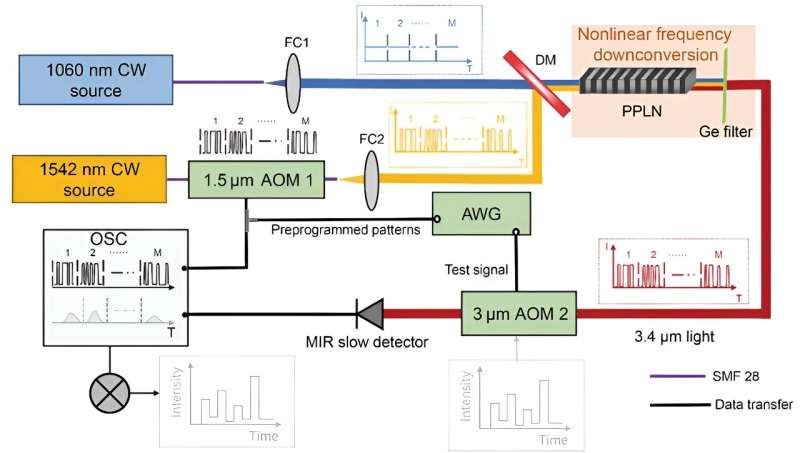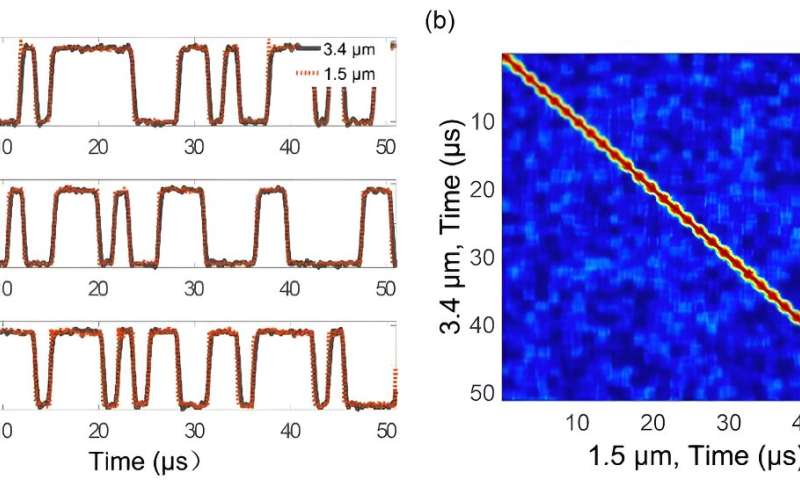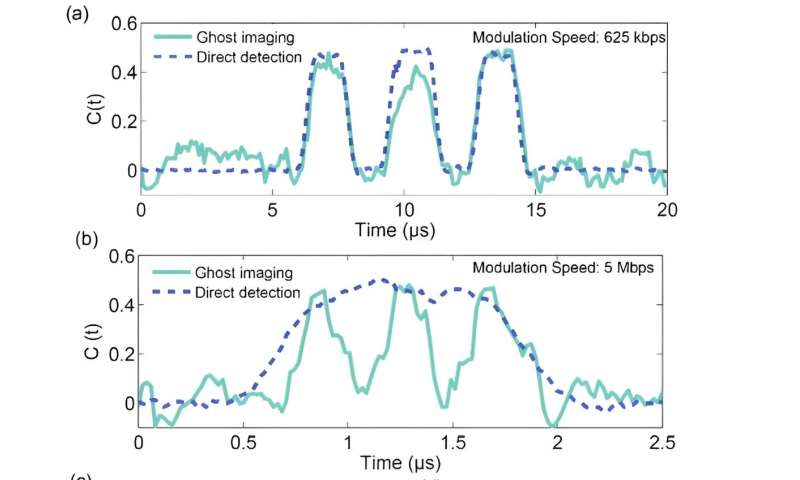by Light Publishing Center, Changchun Institute of Optics, Fine Mechanics And Physics, CAS

Ghost imaging in the time domain allows for reconstructing fast temporal objects using a slow photodetector. The technique involves correlating random or pre-programmed probing temporal intensity patterns with the integrated signal measured after modulation by the temporal object. However, the implementation of temporal ghost imaging necessitates ultrafast detectors or modulators for measuring or pre-programming the probing intensity patterns, which are not available in all spectral regions especially in the mid-infrared region.
In a new paper published in Light: Science & Application, a team of scientists, led by Prof. Houkun Liang from Sichuan University, China and Prof. Goëry Genty from Tampere University, Finland, and co-workers have developed a frequency downconversion temporal ghost imaging (TGI) scheme that enables extending the operation regime to arbitrary wavelengths regions where fast modulators and detectors are not available. The approach modulates a signal with temporal intensity patterns in the near-infrared and transfers the patterns to an idler via difference-frequency generation in a nonlinear crystal at a wavelength where the temporal object can be retrieved.
As a proof-of-concept, scientists demonstrated a computational temporal ghost imaging in the mid-infrared with operating wavelength that can be tuned from 3.2 to 4.3 μm. The scheme is flexible and can be extended to other regimes. The results introduce new possibilities for scan-free pump-probe imaging and the study of ultrafast dynamics in spectral regions where ultrafast modulation or detection is challenging, such as the mid-infrared and THz regions.
-

Transfer the preprogrammed temporal probing patterns from the near- to mid-infrared spectral region. (a) Comparison of time-resolved intensity profiles of 1542 nm light modulated by the pre-programmed randomly selected binary patterns (red) and 3.4 μm idler temporal intensity after the PPLN crystal (black). (b) Time-to-time intensity fluctuations cross-correlation between the 1542 nm signal and 3.4 μm idler calculated over 250 temporal windows containing different probing patterns. Credit: Light: Science & Applications (2024). DOI: 10.1038/s41377-024-01426-0
-

Mid-infrared TGI results using pre-programmed, randomly selected probing patterns. (a) Experimental ghost image (cyan solid line) of a temporal object with a modulation speed of 625 kbps retrieved from 250 distinct temporal probing patterns. (b) Experimental ghost image of a temporal object with a modulation speed of 5 Mbps. In (a) and (b) the blue dashed line corresponds to direct detection with a 1 MHz bandwidth mid-infrared photodetector. (c) and (d) shows additional TGI results of other examples of 5 Mbps temporal objects. The orange and purple dashed lines represent the corresponding bit sequences measured at the output of the AWG. Credit: Light: Science & Applications (2024). DOI: 10.1038/s41377-024-01426-0
These scientists summarize the operational principle of mid-infrared temporal ghost imaging, saying, “The absence of suitable instrumentation, such as ultrafast mid-infrared electro-optic modulators for pre-programming temporal patterns at mid-infrared light sources, has been a bottleneck in the direct implementation of computational TGI in the mid-infrared. In the proposed new scheme, instead of directly pre-programming temporal patterns at mid-infrared wavelengths, we modulate pre-programmed temporal patterns at near-infrared wavelengths using a conventional telecom modulator and, subsequently, these modulated patterns are transferred to a mid-infrared idler via difference-frequency generation using a temporally stable continuous-wave near-infrared pump light source.
“The wide availability of tunable lasers in the near-infrared allows for flexible and versatile operation of the downconversion TGI scheme, enabling to extend TGI to wavelength regimes where there is a lack of fast detectors and modulators. Using this approach, we have experimentally demonstrated computational TGI in the wavelength range from 3.2 to 4.3 μm. Besides, orthogonal temporal patterns can be used in computational downconversion TGI to reduce the number of distinct probing measurements.
“The presented technique can provide new possibilities for the study of ultrafast dynamics in the mid-infrared spectral region and high-speed free-space optical communications in atmospheric transmission windows even in the presence of atmospheric turbulence. We emphasize that the concept of frequency downconversion ghost imaging is generic, and it can also be applied in the spatial and spectral domains, which could open a new venue for single-pixel imaging and spectroscopy in the mid-infrared and THz regions.”
More information:
Han Wu et al, Mid-infrared computational temporal ghost imaging, Light: Science & Applications (2024). DOI: 10.1038/s41377-024-01426-0
Provided by
Light Publishing Center, Changchun Institute of Optics, Fine Mechanics And Physics, CAS
Citation:
Proof-of-concept study demonstrates mid-infrared computational temporal ghost imaging (2024, August 26)
retrieved 26 August 2024
from https://phys.org/news/2024-08-proof-concept-mid-infrared-temporal.html
This document is subject to copyright. Apart from any fair dealing for the purpose of private study or research, no
part may be reproduced without the written permission. The content is provided for information purposes only.
